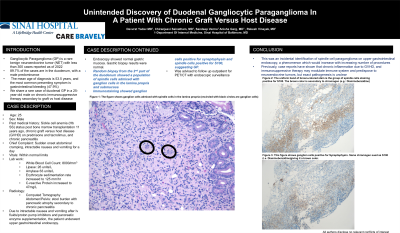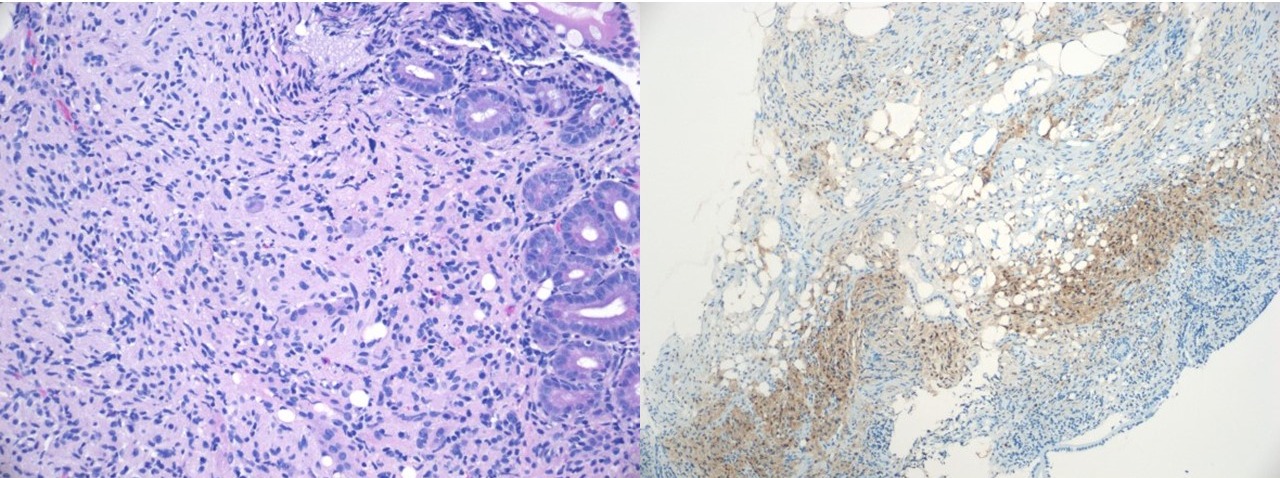Sunday Poster Session
Category: Small Intestine
P1334 - Unintended Discovery of Duodenal Gangliocytic Paraganglioma in a Patient With Chronic Graft-vs-Host Disease
Sunday, October 22, 2023
3:30 PM - 7:00 PM PT
Location: Exhibit Hall

Has Audio

Devvrat Yadav, MBBS
Mayo Clinic
Baltimore, MD
Presenting Author(s)
Devvrat Yadav, MBBS1, Chiranjeevi sainatham, MBBS2, Sandeep Verma, MD2, Anisha Garg, MBBS2, Rakesh Vinayek, MBBS2
1Mayo Clinic, Baltimore, MD; 2Sinai Hospital, Baltimore, MD
Introduction: Gangliocytic paraganglioma (GP) is a rare benign neuroendocrine tumor (NET) with less than300 cases reported as of 2022. 89.7% of the cases are in the duodenum, with a male predominance. The mean age of diagnosis was 53.5 years; the most common presenting symptom is GI bleeding (47.9%). The prognosis is excellent, with a 100% 5-year survival rate. We share a rare case of a duodenal GP in a young male on chronic immunosuppressive therapy secondary to graft versus host disease (GVHD).
Case Description/Methods: A 25-year-old man with a history of sickle cell anemia (Hb SS) status post bone marrow transplantation 11 years ago, chronic GVHD on prednisone and tacrolimus, and chronic pancreatitis presented with sudden onset abdominal cramping, intractable nausea, and vomiting for 1 day. Vitals were stable, and physical examination was unremarkable except for mild abdominal tenderness. Initial blood work showed WBC 8K/mm, lipase 26 units/L, amylase 62 Units/L, erythrocyte sedimentation rate 125 mm/h, and C-reactive protein 47 mg/L. X-ray abdomen showed a non-obstructive bowel gas pattern, and computerized tomography of the abdomen and pelvis showed colonic stool burden and pancreatic atrophy secondary to chronic pancreatitis. He was started on IV fluids, proton pump inhibitors, pancreatic enzyme supplementation, and metoclopramide. He underwent upper endoscopy, which was unremarkable and gastric biopsies were normal. Biopsy results from the 2nd part of the duodenum showed a population of spindle cells admixed with ganglion cells in the lamina propria and the submucosa (Figure 1(a)). Immunostaining showed ganglion cells positive for synaptophysin and spindle cells positive for S100,suggesting GP (Figure 1(b)). Over time, he continued to have persistent abdominal pain. MRI-MRCP was negative for any duodenal/pancreatic mass or biliary dilation. He was advised to follow up outpatient for PET/CT with endoscopic surveillance.
Discussion: As increasing number of upper GI endoscopies are performed each year, we may encounter more incidentally diagnosed cases of NET's in the gut. Previous case reports have shown that chronic inflammation due to GVHD, and immunosuppressive therapy may modulate the immune system and predispose to neuroendocrine tumors, but the exact pathogenesis is unclear. Further studies are needed to understand the association between GVHD, immunosuppressive medications, and NET.

Disclosures:
Devvrat Yadav, MBBS1, Chiranjeevi sainatham, MBBS2, Sandeep Verma, MD2, Anisha Garg, MBBS2, Rakesh Vinayek, MBBS2. P1334 - Unintended Discovery of Duodenal Gangliocytic Paraganglioma in a Patient With Chronic Graft-vs-Host Disease, ACG 2023 Annual Scientific Meeting Abstracts. Vancouver, BC, Canada: American College of Gastroenterology.
1Mayo Clinic, Baltimore, MD; 2Sinai Hospital, Baltimore, MD
Introduction: Gangliocytic paraganglioma (GP) is a rare benign neuroendocrine tumor (NET) with less than300 cases reported as of 2022. 89.7% of the cases are in the duodenum, with a male predominance. The mean age of diagnosis was 53.5 years; the most common presenting symptom is GI bleeding (47.9%). The prognosis is excellent, with a 100% 5-year survival rate. We share a rare case of a duodenal GP in a young male on chronic immunosuppressive therapy secondary to graft versus host disease (GVHD).
Case Description/Methods: A 25-year-old man with a history of sickle cell anemia (Hb SS) status post bone marrow transplantation 11 years ago, chronic GVHD on prednisone and tacrolimus, and chronic pancreatitis presented with sudden onset abdominal cramping, intractable nausea, and vomiting for 1 day. Vitals were stable, and physical examination was unremarkable except for mild abdominal tenderness. Initial blood work showed WBC 8K/mm, lipase 26 units/L, amylase 62 Units/L, erythrocyte sedimentation rate 125 mm/h, and C-reactive protein 47 mg/L. X-ray abdomen showed a non-obstructive bowel gas pattern, and computerized tomography of the abdomen and pelvis showed colonic stool burden and pancreatic atrophy secondary to chronic pancreatitis. He was started on IV fluids, proton pump inhibitors, pancreatic enzyme supplementation, and metoclopramide. He underwent upper endoscopy, which was unremarkable and gastric biopsies were normal. Biopsy results from the 2nd part of the duodenum showed a population of spindle cells admixed with ganglion cells in the lamina propria and the submucosa (Figure 1(a)). Immunostaining showed ganglion cells positive for synaptophysin and spindle cells positive for S100,suggesting GP (Figure 1(b)). Over time, he continued to have persistent abdominal pain. MRI-MRCP was negative for any duodenal/pancreatic mass or biliary dilation. He was advised to follow up outpatient for PET/CT with endoscopic surveillance.
Discussion: As increasing number of upper GI endoscopies are performed each year, we may encounter more incidentally diagnosed cases of NET's in the gut. Previous case reports have shown that chronic inflammation due to GVHD, and immunosuppressive therapy may modulate the immune system and predispose to neuroendocrine tumors, but the exact pathogenesis is unclear. Further studies are needed to understand the association between GVHD, immunosuppressive medications, and NET.

Figure: Figure 1(a): Spindle Cells Admixed with Ganglion Cells in Lamina Propria and Submucosa; Figure 1(b): Immunostaining Showing Spindle Cells Positive for S100
Disclosures:
Devvrat Yadav indicated no relevant financial relationships.
Chiranjeevi sainatham indicated no relevant financial relationships.
Sandeep Verma indicated no relevant financial relationships.
Anisha Garg indicated no relevant financial relationships.
Rakesh Vinayek indicated no relevant financial relationships.
Devvrat Yadav, MBBS1, Chiranjeevi sainatham, MBBS2, Sandeep Verma, MD2, Anisha Garg, MBBS2, Rakesh Vinayek, MBBS2. P1334 - Unintended Discovery of Duodenal Gangliocytic Paraganglioma in a Patient With Chronic Graft-vs-Host Disease, ACG 2023 Annual Scientific Meeting Abstracts. Vancouver, BC, Canada: American College of Gastroenterology.
